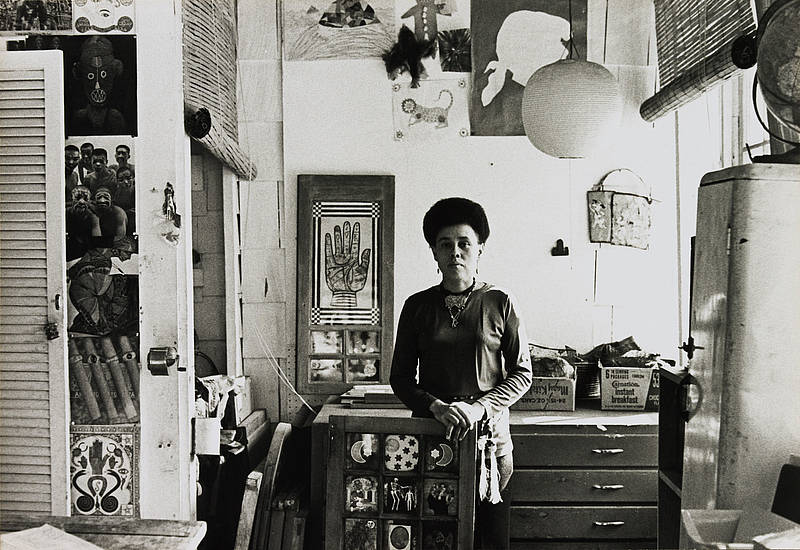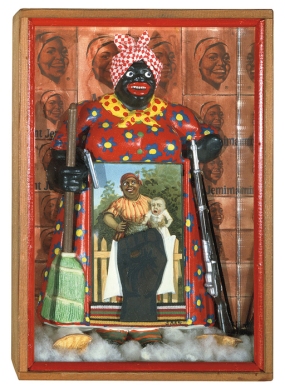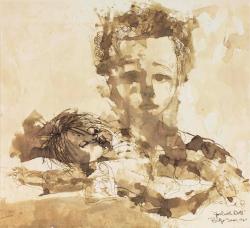Betye Saar – Artist & Educator

“There has been an apparent thread in my art that weaves from early prints of the 1960’s through later collages and assemblages and ties into the current installations. That thread is a curiosity about the mystical.
I am intrigued with combining the remnant of memories, fragments of relics and ordinary objects, with the components of technology. It’s a way of delving into the past and reaching into the future simultaneously. The art itself becomes the bridge.”[1]
Curiosity
about the unknown
has no boundaries.
Symbols, images, place and cultures merge.
time slips away.
The stars, the cards, the mystic vigil
may hold the answers.
By shifting the point of view
an inner spirit is released.
Free to create.[1]
Betye Saar
1998

Betye Saar is an American artist and educator, renowned for her assemblages that lampoon racist attitudes about blacks and for installations featuring mystical themes.[2]
Betye Saar was born in Los Angeles in 1926. She graduated from the University of California, and continued graduate studies at California State University at Long Beach, the University of Southern California, and California State University at Northridge. Saar is known for her multimedia collages, box assemblages, altars and installations consisting of found materials.[3]

A pioneer of second-wave feminist and postwar black nationalist aesthetics—whose lasting influence was secured by her iconic reclamation of the Aunt Jemima figure in works such as The Liberation of Aunt Jemima (1972)—Betye Saar began her career in design before transitioning to assemblage and installation. [4]
“I am a mixed media collage, assemblage and installation artist. The concepts of passage, crossroads, death and rebirth have been underlying elements in much of my work. My art continues to move in a creative spiral. Much of my current work is about issues of race and gender; a return to my concerns of 1972 and The Liberation of Aunt Jemima. Mystery and beauty remain constant forces behind my creative energy. This is the energy that spins the spiral.”[3]
—Betye Saar, 2007
In subsequent works Saar evoked her bittersweet youth in the twenties and thirties, making assemblages that included faded bits of lace, photographs, and other memorabilia. In her most recent art, Saar’s social commentary has been enriched by personal symbolism tied to her own emotional explorations.[5]
The information on this web-page is for educational and research purposes. Article entries and images are not my own. Please review sources and links above for more information. This blog post is for educational purposes only and for sharing valuable information to others interested in the arts.
Thank you.
Sources:
[2]https://www.britannica.com/biography/Betye-Saar
[3]https://www.brooklynmuseum.org/eascfa/feminist_art_base/betye-saar
[4]https://hammer.ucla.edu/now-dig-this/artists/betye-saar/
[5]https://americanart.si.edu/artist/betye-saar-6576
Additional Sources:
https://www.moma.org/artists/5102
http://www.michaelrosenfeldart.com/artists/betye-saar-b1926 – Girl with Doll, 1964, brown ink and wash on paper mounted on illustration board, 18 3/4″ x 20 7/8″ sheet size / 15″ x 16 1/2″ sight size
*More information about To Catch a Unicorn, 1960
https://www.alexandergray.com/attachment/en/594a3c935a4091cd008b4568/News/5af5c7e5f5c038291e8b4567 Saar’s etching from 1960—made in the early years of her career—alludes to elements of spirituality and the cosmos that appear in her later work, but it also references the period’s racial landscape. While the stylized scene is set in a familiar forest setting, it departs markedly from the Eurocentric lineage of unicorn images. A nude black woman leans against a unicorn, the curves of her body contrasting with the animal’s long, thin neck and angular limbs. Above them are the moon and the sun, perhaps a nod to the passing of time. The moon is also associated with femininity in many cultures, and Saar here celebrates and honors female power.
Famous Women in Art Kymberli's Art Blog Quick Art History Reads altars american artisit Art art by betye saar artist betye artist social commentary arts education aunt jemima betye saar black collage artist black female artist black mixed media artists black women unicorn blakc women artist box assemblages collage collage artist educator betye saar found material art found materials installation installation artist installation black artist kymberli grant kymberli grant writing la art liberation mixed media social commentary unicorns usc art usc artist writing art history
